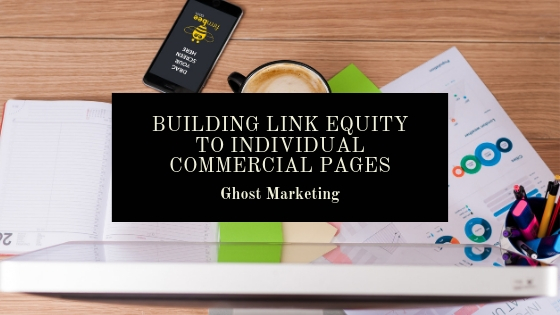Why can’t we just build links to commercial pages?
This is a question we’ve been getting a lot recently, so instead of explaining one by one, we decided to develop this guide to explain in-detail the limiting elements around trying to build links to commercial pages directly. Although this isn’t impossible it does impact the volume and velocity of specific link building campaigns.
Contents
What’s a “Commercial” Page?

A commercial page is any URL on your website that acts as a lead generation, sales generation or high priority “money page” for your business. In short this is usually the services you offer or products you sell.
The problem with commercial pages is everyone on the planet, regardless of the quality of their site knows that these pages are trying to sell something. If you land on a category or product page of an Ecommerce store, it’s pretty clear that’s a commercial searcher intent page.
Pre-framing; Content Vs Commercial
Content pieces, on the other hand, are usually longer-form blog posts, graphics, videos or text that is designed to educate or entertain a visitor. These are usually extremely non-commercial and in most cases, you won’t even remember which site you read that information on.
Although content nowadays is an incredibly effective marketing strategy, in most cases it is still simply used to educate a user (Wikipedia, for example, is 100% non-commercial content). This is also why no one has issues linking to Wiki, there’s no commercial intent behind it.
As a result, people freely link to Wikipedia, but for you and your commercial pages?
No one is going to link to them!

Because people know linking to you leads directly to cold hard cash for your business, even if they don’t really understand how everything works. As a result, a lot of webmasters are going to quote you a price to link or mention your website or business. This is usually a ridiculous price in the form of an editorial fee, sponsored post, link insertion or some other way to try to get money from you.
Webmasters also know that this doesn’t really add much value. If I’m researching link building for example and someone links to a service – I’m unlikely to click through, but a link to a great tutorial on how to generate links in a specific way? That’s something that’ll increase overall quality of the post and add value to the reader too.
As a result, when this attempted commercial link building happens, the entire link building process becomes incredibly expensive and overall less effective as a result. Instead, we want to focus on generating links to specific content pieces to remove that commercial barrier. I’m not going to go in-depth in this post into the link building process or content development plans as we have multiple guides on the blog around those, instead, we’re going to talk about how to get the most bang for your buck from a link building point of view.
Passing Link Equity & Creating an Internal Linking Plan

As building links directly to commercial pages is so expensive, instead we want to link to content pieces on our website and then pass the “Link juice” from those internal pages to the page we’re looking to rank.
In theory, it’s an easy game;
- Generate links to a content piece.
- Internally link from that content piece to the original commercial page you want to rank.
In practice though, it’s a little more difficult and there are a few nuisances you’ll need to know.
We’ve already generated an industry leading internal linking guide for anyone unfamiliar with that terminology and Sam Oh of Ahrefs has a great video on this topic to which is embedded below. This will help you understand the terminology as well as some more information on who all of this needs to be implemented in the first place.
Where to start?
The best place to start is to focus on URL’s that are “almost” ranking. This is how our agency is able to develop such high converting and high return on investment link building campaigns, we focus on keywords that are very close to being profitable (top of page 1) but aren’t quite there yet. Again there’s a full guide on this concept here.
Once you have your link targets you want to break them down by content pages and commercial pages. Assuming we can build links more easily to content pieces we’re going to keep those in the list. The commercial pages we want to “merge” into this list through internal linking.
Let’s assume you have 10 URLs you are looking to build links to after reverse engineering the link targets based on your current organic rankings, as well as analysing the quickest ROI increase. After this, you split into commercial and content. And there’s 4 content pieces and 6 commercial pages. From here you’ll want to internally link TO those 6 commercial pages within those 4 pieces of content (it’s also a good idea to re-build and make these content pieces even better before starting your outreach). Again, if you are unsure about internal linking then head over to our guide.
From here you’ll only have 4 core content pieces that will act as great opportunities to build links to. Not only this but at the same time you’ll be generating link equity through those internal links to the commercial pages, without sacrificing the quality of the link building campaign. AND another great benefit is this cuts down the total number of URL’s you need to build links to from 10 to 4. That’s a win-win-win situation.
